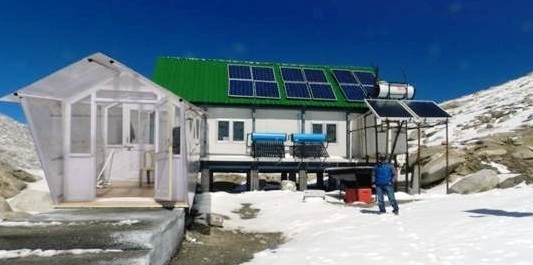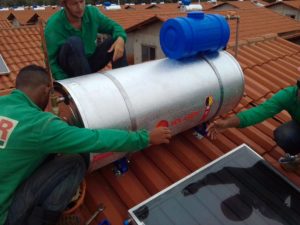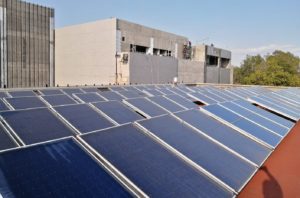India: Vacuum Tube System with PCM Storage Tank Heats Troop Shelter
October 28, 2016
 The Indian Defence Institute of High Altitude Research (DIHAR), a laboratory of the Defence Research Development Organisation, has successfully tested a vacuum tube collector system for space heating at extreme altitudes. The testing site, a troop shelter, was set up last year in the region of Ladakh in the northern Indian state of Jammu and Kashmir at the Chang La, a high mountain pass at 5,360 metres above sea level, and the tests were conducted there over the winter. The system stores solar heat harnessed during the day in a phase-change storage tank and uses it to keep the 90 m² shelter warm at night. During the test run, the inside of the shelter showed between 7 and 10 °C while the temperature outside was minus 30 °C.
The Indian Defence Institute of High Altitude Research (DIHAR), a laboratory of the Defence Research Development Organisation, has successfully tested a vacuum tube collector system for space heating at extreme altitudes. The testing site, a troop shelter, was set up last year in the region of Ladakh in the northern Indian state of Jammu and Kashmir at the Chang La, a high mountain pass at 5,360 metres above sea level, and the tests were conducted there over the winter. The system stores solar heat harnessed during the day in a phase-change storage tank and uses it to keep the 90 m² shelter warm at night. During the test run, the inside of the shelter showed between 7 and 10 °C while the temperature outside was minus 30 °C.Photo: DIHAR
“However, there is a need to operate a diesel generator for six hours during the peak winter months January and February when the temperature falls below minus 30 °C,” Sarfraz Nazir explained in a report on defencenews.in this July. Nazir is a scientist at DIHAR and the initiator of the project. Each of the collectors has 30 tubes with a length of 1,800 mm each, which can save anywhere between 6 to 10 litres of paraffin oil per day when ambient temperatures do not fall below -30 °C.
Usually, the army employs bhukaris – wood-burning stoves – and generator-run electrical appliances to warm up facilities such as barracks and bunkers in Ladakh as well as the northeast. These systems consume hundreds of thousands of litres of paraffin oil and diesel each year.
 This troop shelter set up last year has 90 m² of floor space and was heated by solar thermal technology during the wintertime.
This troop shelter set up last year has 90 m² of floor space and was heated by solar thermal technology during the wintertime.Photo: DIHAR
“The idea struck my mind in early 2014 when I collected the solar radiation data of this area,” Nazir said. The researcher found that “both the intensity and sunshine duration” were rather high, and that the amount of irradiation could be used very efficiently to warm up rooms if a suitable solar thermal system were selected to replace fossil fuel-based burners. Nazir started working on the design of a prototype: After 18 months of research, he finally succeeded in creating the first demonstration shelter heated by the sun.
The scientists at DIHAR used HS 29 – a mixture of calcium chloride and other salts – as the phase change material in the tank to store thermal energy harnessed by the evacuated tube collectors. The HS 29 melts when solar heat is led into the tank and becomes solid again when heat is released at night.
Tank heat is distributed through water pipes, which have been integrated into the roof of the shelter. The building has a greenhouse-like thermal trap area over the roof to create a tunnelling effect and trap solar heat in the shelter, according to the online article by DIHAR.
This new eco-friendly development is seen as a major breakthrough which will benefit such ecologically sensitive areas above and beyond a mere reduction in greenhouse gases. Most important, it will give the necessary comfort to soldiers who are constantly struggling with the cold temperatures in this region of the Himalayas. After the successful pilot test, DIHAR is planning to deploy these shelter installations at several hundred other buildings.
More information:


